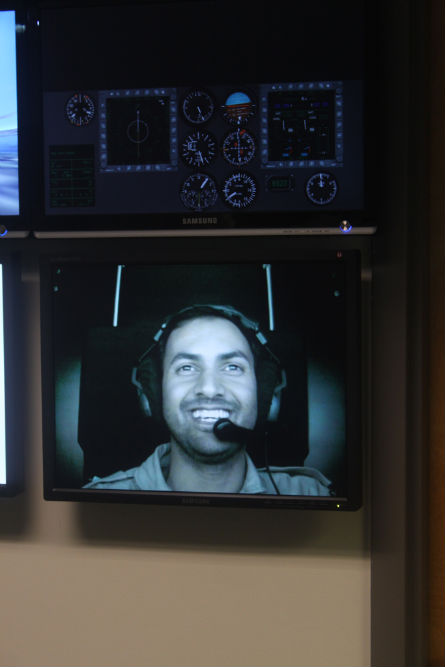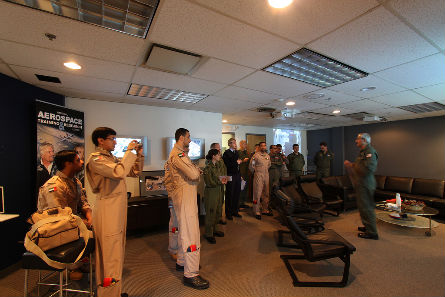Pilot Ahmed Al-Menhai of the United Arab Emirates has landed, and he bursts into the room with a heavy limp. He hurls himself onto a small couch and tears off his boot to massage his foot and stamp it on the carpet. His foot is numb and swollen despite his g-suit. Several National Aerospace Training and Research Centre (NASTAR) staffers circle the couch, inquiring about the sensation in Al-Menhai's foot. He has just experienced an 8min flight and 7g in a Boeing F-15 as part of NASTAR's Orange Flag exercise - and he never left the ground.
NASTAR, a subsidiary of Environmental Tectonics (ETC), specialises in ground-based simulations that enable pilots to safely explore the dangers of flying combat fighter aircraft using exercises and training courses that include g-tolerance improvement, tactical and spatial disorientation, and land and water survival training. The training is not just for aspiring pilots, but also for those seeking to hone their existing physiological thresholds and tactical skills.
Orange Flag, a three-day event held in mid-October at NASTAR's facility near Philadelphia, introduced military pilots, flight physiology specialists, engineers and operations specialists from seven countries to the company's latest high-g flight simulators.
ETC claims to be unique in the flight simulation world by working to advance the science and practice of pilot training and - especially for military pilots - by going beyond the traditional six degrees of freedom hexapod platform simulator experience to acclimatise pilots to high g-forces by strapping them into a cockpit mounted on a centrifuge. Here, trainees get the practice that could save their lives during the intense mental and physiological rigours of routine military flight - or the crisis of a loss-of-control or spatial disorientation incident, the number one cause of US commercial fatalities.
Using centrifuge-based simulators, NASTAR trains pilots to increase their chances of recovery during the sensory and psychological chaos of loss-of-control, spatial disorientation or GLOC, in which sustained high g-force drains oxygenated blood from the brain.
 |
|---|
ETC's upset recovery expert Paul Comtois sizes up the company's Phoenix centrifuge simulator during the Orange Flag exercise |
Paul Comtois, director of the NASTAR Centre's Aircraft Upset Recovery Training and Research and a 23-year veteran of the US military, says it takes 8s for the oxygen-deprived brain to shut down. The Aviation, Space and Environmental Medicine journal notes that between 1982 and 2002, 30% of single-crew member aircraft GLOC events resulted in a crash, with a fatality rate of 73%, and a fatality rate of 100% for attack aircraft.
LOSE PILOTS
NASTAR programme manager Glenn King says armed forces worldwide, including the US Navy and US Air Force, continue to lose pilots to GLOC. This year, a test pilot for Lockheed Martin, while manoeuvring at Mach 1.6 in an F-22 Raptor, spent a few seconds in g-induced ALOC (almost loss of consciousness) and plummeted into an unrecoverable 14,000ft (4,265m) nosedive.
The g-force testing at NASTAR is meant to save lives, whether pilots increase their g-force tolerance through practice, or master something seemingly simple, such as correct breathing techniques. That is where the company's Authentic Tactical Flight Simulator-400 (ATFS-400) Phoenix comes in.
At first sight, NASTAR looks like any warren of cubicles in suburban Philadelphia. The only clues to the aeronautical wizardry just beyond the desks are the office's restroom doors, which, instead of bearing traditional male/female figures, feature silhouetted forms in flight suits.
Through the double doors at the back, the bright, lofty space looks like an aviation theme park full of top-notch virtual reality rides, with banks of computer control stations instead of arcades. Here, pilots can experience virtually any in-flight crisis, because, as Comtois says, "we're built for the ground". In addition to the hypobaric altitude chamber, where entire aircrews learn first-hand how much the symptoms of hypoxia can vary from person to person, NASTAR has an ejection seat simulator, where pilots learn the correct posture to prevent spinal injury as they rocket out of a faltering jet, and a variety of sustained-g simulators such as the GyroLab 2000, used to train pilots in upset recovery, including stalls and spins, as well as in spatial disorientation and sustained g effects.
However, the ejection seat simulator and GyroLab 2000 are little sisters to the queen bee for Orange Flag - the Phoenix, a unit that occupies its own hangar.
Pilot Al-Menhai is ready for his flight in the Phoenix, and a NASTAR Centre staffer helps him into his "speed jeans" - the g-suit whose air tubing will compresses his legs and abdomen, keeping blood in his brain as the high g-force tries to pool blood in his extremities.
Al-Menhai descends to the presence chamber of the ATFS-400, which is equipped with computer-generated visuals. NASTAR uses this full-motion centrifuge simulator to train pilots in the mental and physiological stress of flying at up 9g. For Orange Flag, pilots from the USA, Canada, Germany, Oman and elsewhere experienced not just solo "flights", but also one-on-one missions in the same virtual environment with the Phoenix linked to the integrated physiological trainer-II, another in-house simulator which, for Orange Flag, was set up to model a Sukhoi Su-30 cockpit.
At the end of its 7.6m centrifuge arm, the Phoenix cockpit today is a fullyflyable F-15 cockpit, although with the help of different external modules, it can become an F-16 or even a seat on a space shuttle. Every switch, button, dial and control Al-Menhai knows from the F-15 is here, and his seat faces a miniature IMAX screen for one, where he will view an in-motion computer-generated imagery panorama of the Grand Canyon on a liquid crystal on silicon display - the highest resolution currently available on the market.
His mission for Orange Flag is to drop ordnance onto an enemy vessel in the Colorado River. During the pre-flight checklist, which includes harness, seat height and g-suit hook-up, Al-Menhai is asked: "How many gs?" King says the ATFS-400 can achieve up to 15g for testing purposes, although actual human capability cannot push the limit beyond 9g.
"Nine," says Al-Menhai. His NASTAR assistant slaps his shoulder: "Have a good flight."
 |
|---|
An Orange Flag pilot is monitored by ETC experts during a sustained-g "mission" |
It's time to clear the path of the centrifuge. The upstairs control room has screens for Al-Menhai's computer-generated imagery, the Phoenix flight computer, and Al-Menhai's face in the cockpit. King presides over the "flight", as he should - he has spent 2,500h in centrifuge simulators worldwide, including more than 200h in the Phoenix, a statistic he says "climbs daily". King will read Al-Menhai's face on the monitor like an English professor reads a book, looking for tell-tale stress in the pilot's eyes and breath. As a pilot strays into ALOC, says King, his eyes lose focus and begin to wander. It is then up to King to determine whether continuing the exercise will help pilots "learn their own physical limitation to g forces" or whether a termination is necessary because imminent GLOC. "Give a pilot two hours in the simulator with me," says King, "and I will bring up his sustainable threshold by one g."
The centrifuge begins to swoop into a measured, deceptively powerful blur and the hum of the machinery saturates the air. During a 9g spin, the Phoenix's arm moves at about 70km/h (45mph) at the tip, with a rotational mass of about 11t. Any facility housing the Phoenix must accommodate this whirling device with a safety zone of at least 0.9m around its circumference.
As Al-Menhai navigates the Grand Canyon in the next room, Comtois explains how glad he is of today's technology for pilot training, especially for the time he ejected from his F-16 over the Gulf of Mexico. He says it was "training plus technology" that enabled him to survive. Comtois stresses that the Phoenix will not replace the sixdegrees of freedom hydraulic or electric platforms that teach pilots the sensations of pitch, roll and yaw, but pilots need the g-tolerance training ETC's simulators provide.
 |
|---|
Orange Flag participants are briefed by NASTAR programme manager Glenn King |
NASTAR hopes the Phoenix will become a standard addition not just to military, but also to commercial training. Two decades ago, most commercial pilots began their careers in military jets, but this is no longer the case. Comtois says today's commercial pilots often lack the "training to the edge of the envelope" that military pilots get, which could make all the difference in an emergency. There are also practical and financial benefits to training in the Phoenix. NASTAR estimates the Phoenix offers 28 times lower costs per tactical training hour compared with flight in an aircraft. The US Air Force is now a customer after awarding ETC a contract worth more than $35 million for its own ATFS-400. The 9.5m centrifuge will be delivered in 2012 to the Wright Patterson Air Force Base's 711th Human Performance Wing, a unit that melds human performance research and aerospace medicine.
Although critics of centrifuge-based simulation suggest the short spinning radius required for a centrifuge can provide unrealistic g sensations, particularly when a pilot moves his or her head, the Orange Flag flyers did not seem to notice.
TACTICAL AVIATION
Capt David Monk, six-year veteran of the Canadian Air Force's Boeing F-18s who had previous centrifuge experience, says the Phoenix offered g-force training in an unprecedented tactical aviation context, allowing him to fly the simulator, rather than ride it. Monk says the g-forces feel "exactly the same" as in a real aircraft. Pointing out that he doesn't think on-the-ground training could get much better, Monk notes that "it's pretty much impossible to replicate the experience of flying a high-performance aircraft", partly because jets are not equipped with an emergency stop button. "There's always that piece of your brain that knows the simulator isn't real," he says.
But when the newly "landed" Al-Menhai gets the feeling back in his feet, he would probably agree about the realism of the centrifuge gs. "This is normal," he says of his difficulty walking and the hurried loss of his boot after his spin in the Phoenix - that is, if you call hurtling through the air at 7g normal.
Source: Flight International



















